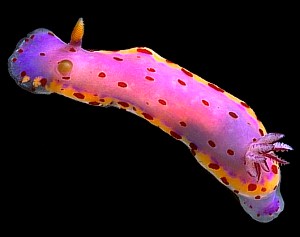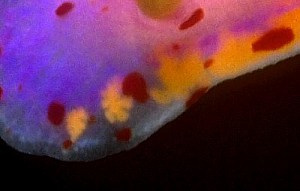

Chromodoris loringi
(Angas, 1864)
Order: NUDIBRANCHIA
Suborder: DORIDINA
Family: Chromodorididae
PHOTO
UPPER: Solitary Is., northern New South Wales, April 1987.
LOWER: Close-up of left side of head showing yellow dendritic mantle glands.
PHOTOS: Bill Rudman.
There are many red and orange-spotted species of chromodorid in New South Wales and southeastern Australia. I have discussed this example of mimicry on a separate page.
References:
• Rudman, W.B. (1983a) The Chromodorididae (Opisthobranchia: Mollusca) of the Indo-West Pacific: Chromodoris splendida, C. aspersa and Hypselodoris placida colour groups. Zoological Journal of the Linnean Society 78: 105-173.
• Rudman, W.B. (1991) Purpose in Pattern: the evolution of colour in chromodorid nudibranchs. Journal of Molluscan Studies, 57, (T.E. Thompson Memorial Issue): 5-21.
Rudman, W.B., 1999 (June 3) Chromodoris loringi (Angas, 1864). [In] Sea Slug Forum. Australian Museum, Sydney. Available from http://www.seaslugforum.net/find/chrolori
Related messages
Chromodoris loringi from Port Stephens, NSW
October 27, 2005
From: L. & D. Atkinson

Dear Bill,
We found this tiny nudibranch during a boat dive with Pro Dive Nelson Bay to Little Island. On the same dive we found a lot of Chromodoris woodwardae that you have already identified for us [message #15063]. We originally thought this one was the same but when the photos came back we could notice some differences that fitted with Chromodoris loringi. Can you confirm the identity of this one?
Locality: Horseshoe Reef, Little Island, offshore from Port Stephens, NSW, Australia. Depth: 18 metres. Length: 5 mm. 15th October 2005. Rocky Reef fringed with sand and sponges. Photographer: Leanne & David Atkinson
Thanks,
Leanne & David Atkinson
atk@hunterlink.net.au
Atkinson, L. & D., 2005 (Oct 27) Chromodoris loringi from Port Stephens, NSW. [Message in] Sea Slug Forum. Australian Museum, Sydney. Available from http://www.seaslugforum.net/find/15115Dear Leanne & David,
Yes this is Chromodoris loringi. You are certainly finding a few of the less common red-spotted chromodorids of southeastern Australia. In fact my redescription of C. loringi (see Rudman, 1983) was the first report of the species since its description in 1864. A another red-spotted species which was misidentified by Tom Thompson (1972) as C. loringi, is what I named C. thompsoni. I note that the Fact Sheets for these species are rather lacking in information. I'll do my best to remedy that in the near future.
Best wishes,
Bill Rudman
Chromodoris loringi from Botany Bay
December 3, 2002
From: Allan Saben

Hi Bill.
I took this pic at Henry's Head, Botany Bay, NSW [Sydney, Australia] in about 22 meters of water. I was wondering whether you could please identify it for me.
Many thanks,
Allan
asaben@bigpond.net.au
Saben, A., 2002 (Dec 3) Chromodoris loringi from Botany Bay. [Message in] Sea Slug Forum. Australian Museum, Sydney. Available from http://www.seaslugforum.net/find/8529Dear Allan,
This is Chromodoris loringi. It is one of a group of similarly coloured species, such as Hypselodoris bennetti and Chromodoris thompsoni which are found only in southeastern Australia. In fact they only occur a little to the north and south of the New South Wales borders.
Best wishes,
Bill Rudman
Chromodoris loringi from Sydney
July 8, 1999
From: Des Paroz

Dear Bill,
Wayne Ellis has helped me identify several of the species around Sydney that I have captured shots of - there is one that he is unsure whether it is Chromodoris woodwardae or C. loringi. I am trying to build up a gallery of pictures on my DIVESITE at http://www.divesite.paroz.com
Any insight you could provide would be enormously appreciated.
Best regards
Des Paroz
Scuba Diver & Instructor
Sydney, Australia
des@paroz.com
Paroz, D., 1999 (Jul 8) Chromodoris loringi from Sydney. [Message in] Sea Slug Forum. Australian Museum, Sydney. Available from http://www.seaslugforum.net/find/1034Dear Des,
This is Chromodoris loringi. It is very similar in colour to Chromodoris woodwardae and the common Hypselodoris bennetti but there are some quite good distinguishing features, unfortunately not too clear in your photo. Would I be right in thinking it is nestling in a deep reddish purple sponge?
In Hypselodoris bennetti the background colour is blue, not pink or reddish as in the other two species and the yellow border goes all the way around the mantle. The white gills and rhinophores are lined with red. In Chromodoris loringi the yellow border does not continue around the front of the mantle, the rhinophores are a translucent yellowish colour and the white gills are lined with reddish-purple. In Chromodoris woodwardae the gills and rhinophores are a translucent white colour, and the yellow border goes all around the mantle. There are other colour differences but they are often subtle so it is best to stick to these ones.
I hope that helps. Any photos of it nestling on possible food sponges, or with egg masses would be interesting to see as it would help us to build up information on the basic biology of these animals.
Best wishes,
Bill Rudman.
